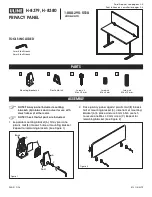
Appendix A: Winter Operations: Snow Plowing Guidelines for
inset Lights
Introduction
Most ADB Safegate light fixtures are low protrusion height and the risk to damage the light is less than with fixtures that
protrude higher above ground. Reinforced prisms are optional available for certain fixtures, further increasing the scratch
resistance for enhanced lifetime. Nevertheless, airport winter operations play a crucial role in protecting in-pavement airfield
ground lights from damage by snowplows.
Airport operators should follow the specifications:
•
FAA AC 150/5200-30D - Airport Winter Safety and Operations
•
FAA AC 150/5220-20A - Airport Snow and Ice Control Equipment
•
FAA AC 150/5340-26C - Maintenance of Airport Visual Aid Facilities
•
FAA EB85 - Ductile Snowplow Protection Ring And Installation Procedures
•
ACRP Report 123 - A Guidebook for Airport Winter Operations
The following instructions provide a summary of these specifications and give additional guidelines, next to the airport
specific and general rules, on damage prevention of airfield inset lights during winter operations.
Anti- and De-icing Chemicals
Chemicals may be required to remove compacted snow from in-pavement light fixtures. However, extensive chemical use
may damage in-pavement light fixtures and underground electrical components resulting in additional electrical maintenance
requirements and costs. De-icing liquids should be used moderately; excessive use will have a negative impact on the
environment and will contaminate the light outlet.
ADB Safegate light fixtures are tested to work with common chemicals on the airfield such as:
•
Potassium Acetate
•
Potassium Formate
•
Sodium Acetate
•
Sodium Formate
The pH value of such chemical solutions should not exceed pH 11 to protect the light fixtures from corrosion and other
damage.
Winter Operation Training
Most airports conduct dry-run winter operations training in advance of the winter season. Winter operation tests and
simulations should be performed on designated and suitable sections of taxiways or runways equipped with the fittings to
be tested. This will help to identify any potential problems and will avoid excessive damages on luminaries and maintenance
vehicles during winter.
Snow and Ice Removal
To prevent damage of in-pavement lights during snow and ice removal a combination of different techniques should be used.
•
In-pavement lights should be turned on at maximum intensity approx. 30-40 min. before the start of snow and ice
removal. The purpose is to ensure melting of snow and ice formation at the light outlets before snow and ice removal.
•
Anti-icing chemicals may be used to prevent ice bonding to the pavement surface. Once the ice has bonded to the
pavement surface, approved de-icing chemicals may be used to melt through the ice pack and/or to break up or weaken
the ice bond.
•
For actual removal snowplows, rotary runway brooms and blowers should be used in combination. By principle:
— Snowplows should be used with the plow blade set at a small distance from the pavement surface for removal
of the majority of snow and ice.
UM-5056, Rev. 1.0.17, 2022/12/08
73
Copyright
©
ADB Safegate, All Rights Reserved
Summary of Contents for AXON FAA L-852A
Page 2: ...UM 5056 Rev 1 0 17 2022 12 08 ...
Page 98: ......
















































